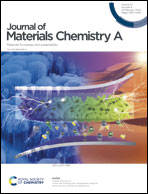A room-temperature self-healing elastomer with ultra-high strength and toughness fabricated via optimized hierarchical hydrogen-bonding interactions†
Abstract
The preparation of room-temperature self-healing polymeric materials with good healing efficiency and high mechanical strength is challenging. Two processes are essential to realise the room-temperature self-healing of materials: (a) a non-crystallised structure and interpenetration and diffusion of polymer chains; (b) fast reorganisation of the intermolecular bonds at damaged sites. Using these strategies, a new polyurethane elastomer is prepared in this study via three-step polyadditions using polytetramethylene ether glycol, isophorone diisocyanate, 2,6-pyridinedimethanol, and 4,4′-methylene bis(2-chloroaniline). The prepared elastomer possesses excellent tensile strength (34.1 MPa), high toughness (127.3 MJ m−3), high fracture energy (119.1 kJ m−2), and good stretchability (2014%). Furthermore, it exhibits strain-induced strengthening behaviour and its mechanical performances are superior to those of previously reported room-temperature self-healing polymer materials. The polyurethane elastomer synthesised via optimized hierarchical H-bonding interactions ultimately exhibited a synchronous self-healing efficiency of more than 83% with tensile strength, elongation, and toughness at 25 °C ± 2 °C after self-healing for 48 h. This study offers beneficial insights into the preparation of room-temperature self-healing polymers with high mechanical strength.



 Please wait while we load your content...
Please wait while we load your content...